Chocolate wars: Italian artisans take on Swiss giant Lindt

Chocolatiers in the northern Italian province of Turin are seeking protected European status for their gianduiotti chocolates - but they face opposition from Lindt, who says it owns the company that invented the treat.
Turin's famed gianduiotto, a small, creamy chocolate that melts on the tongue, is at the centre of a battle for European recognition pitting Italian artisans against Swiss giant Lindt.
In his workshop outside the northwestern Italian city, Luca Ballesio kneads chocolate with spatulas before expertly slicing off pieces and lining them up on a tray.
The 42-year-old is one of the last chocolatiers who makes gianduiotto the old-fashioned way, a hand-made approach which gives the sweets their typical prism shape.
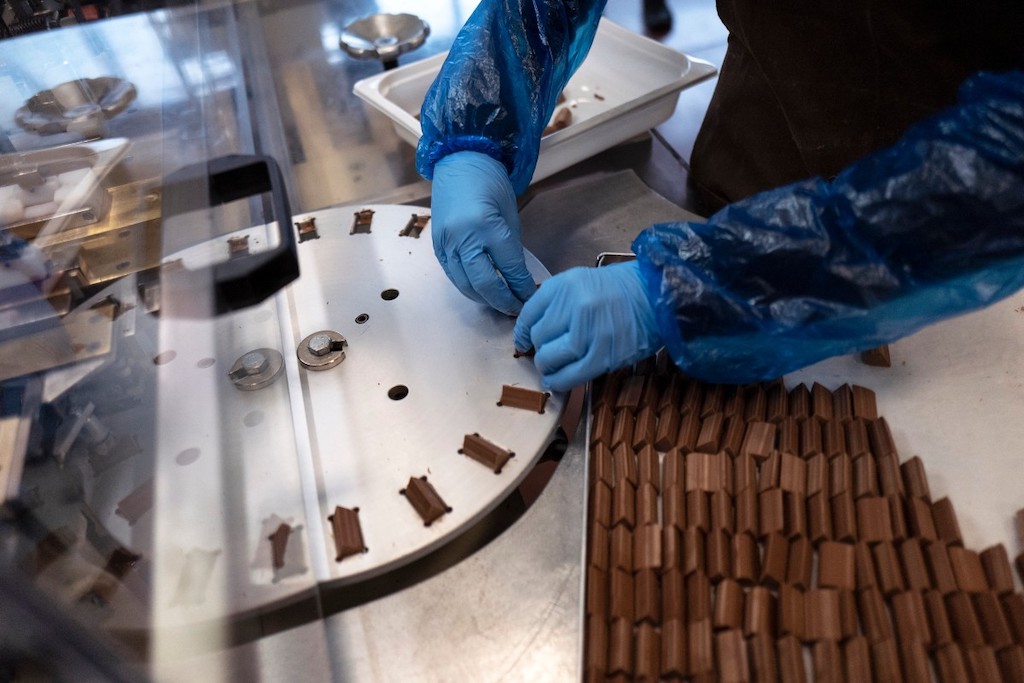
An employee prepares gianduiotti at the Guido Castagna laboratory near Turin on December 12, 2023. Photo by MARCO BERTORELLO / AFP.
He is part of a committee of around 40 artisan chocolatiers, as well as companies such as Ferrero, Venchi and Domori, who are seeking to obtain a Protected Geographical Indication (PGI) for the gianduiotto from the European Union.
The goal is to raise the profile of the chocolate, increase sales - already estimated at around 200 million euros ($219 million) a year - and continue the chocolate tradition in Turin.
READ ALSO: Why did Italy choose opera over espresso in its bid for Unesco status?
But they are facing opposition from Lindt, owner since 1997 of Italian producer Caffarel, which claims to have invented the gianduiotto.
The plan is currently blocked at Italy's ministry of agriculture.
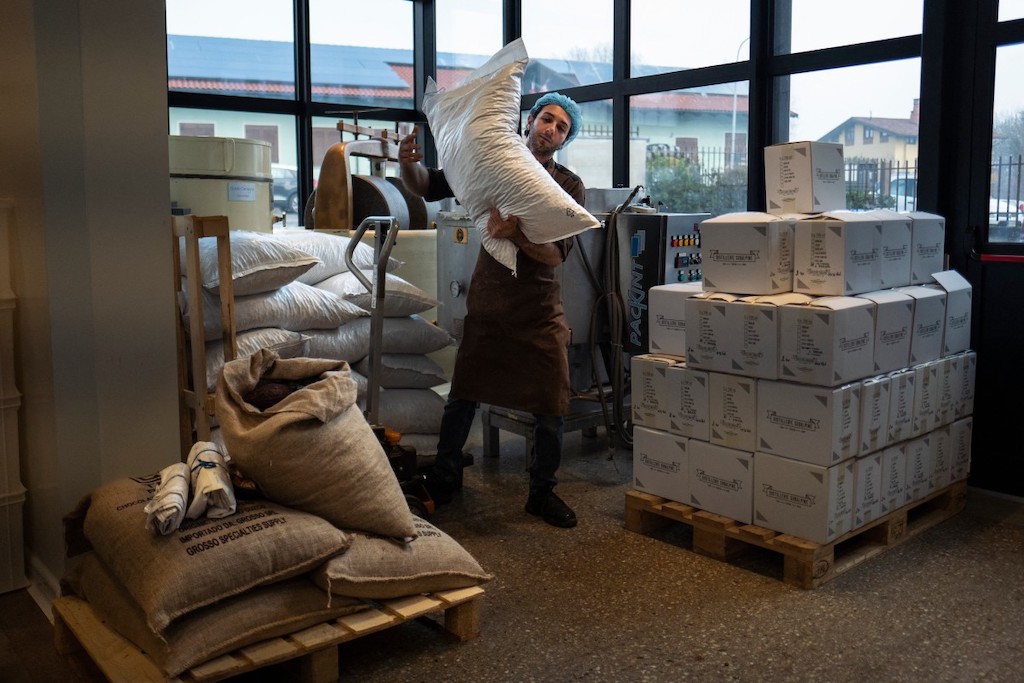
A worker carries a bag of hazelnuts at the Guido Castagna laboratory outside Turin on December 12, 2023. Photo by MARCO BERTORELLO / AFP.
"This battle is important in promoting a historic product of Turin," Ballesio told AFP.
The committee has developed some very detailed criteria, which would have to be met by anyone hoping to secure the hoped-for PGI to their products.
Heresy
Faithful to tradition, it advocates a return to the original gianduiotto - 30 to 45 percent roasted hazelnuts from Piedmont, at least 25 percent cocoa, plus sugar.
The 200-year-old recipe is not, however, to the tastes of Lindt, which requires the addition of powdered milk and wants to reduce the hazelnut content to 26 percent.
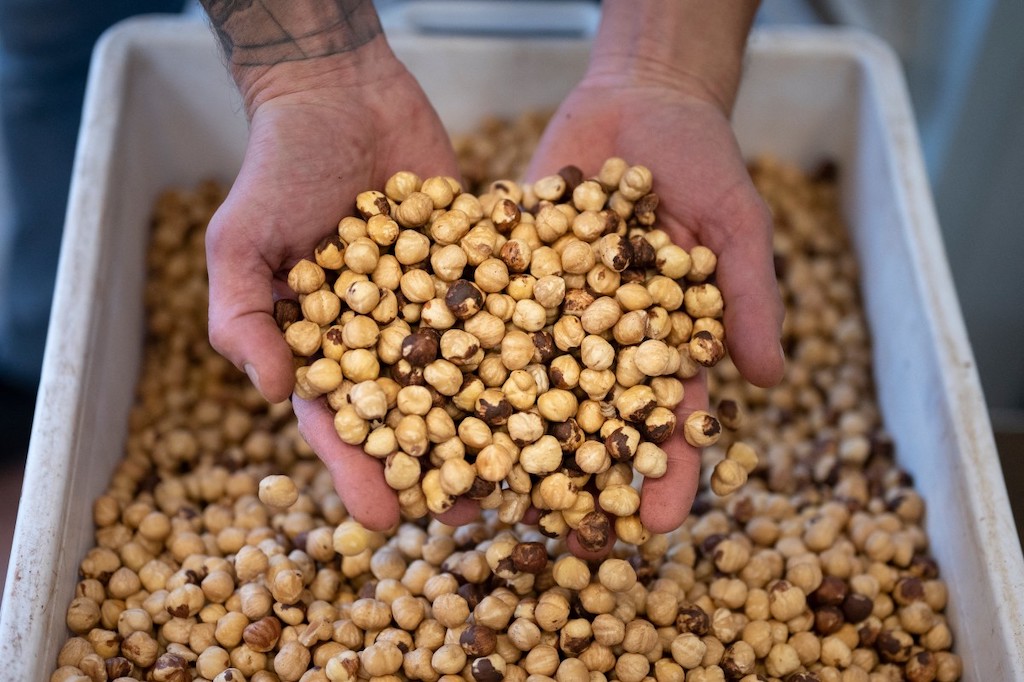
Hazelnuts are a central ingredient in gianduiotti chocolates. Photo by MARCO BERTORELLO / AFP.
The addition of powdered milk for many here is heresy. "For us, adding powdered milk to chocolate is like diluting wine with water," said Guido Castagna, president of the Gianduiotto Committee in Turin.
With Christmas just a few days away, production in 49-year-old Castagna's workshop in Giaveno, near the city, is in full swing.
READ ALSO: Weekend Wanderlust: A love letter to Turin
Castagna pours bag after bag of hazelnuts into a machine which roasts them before they are ground up and mixed with cocoa.
The chocolate mixture then passes through a machine which slices it and pours it directly onto a conveyer belt without using moulds.
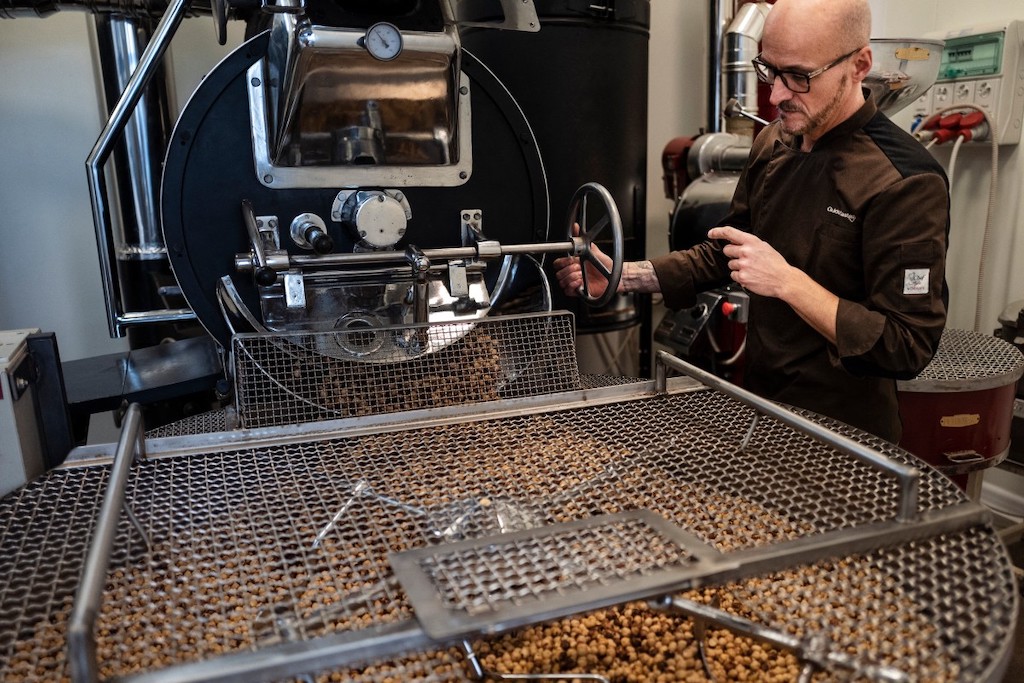
Guido Castagna toasts hazelnuts in his gianduiotti laboratory. Photo by MARCO BERTORELLO / AFP.
Each chocolate is then wrapped by hand in shiny aluminium foil, ready to be placed under the Christmas tree.
"We don't want to take anything away from Caffarel. We're not fighting a war against Caffarel. For us Caffarel can easily continue its production," Castagna told AFP.
- Naval blockade -
"But it must be clear to Caffarel that we are defending the gianduiotto as it was originally made."
Caffarel, for its part, insists it had never opposed the recognition of a PGI certificate, which it says would "contribute to the prestige of gianduiotto in Italy and across the world".
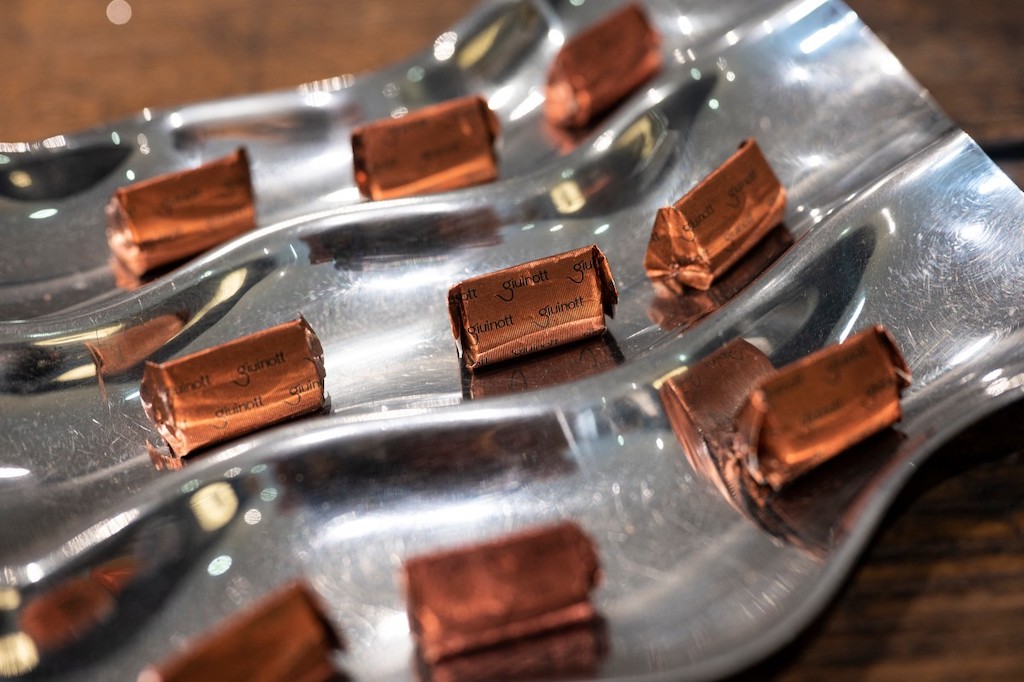
Wrapped gianduiotti laid out on a silver platter. Photo by MARCO BERTORELLO / AFP.
But the Lindt subsidiary already has its own brand, "Gianduia 1865 - the authentic Gianduiotto of Turin" and fears the creation of a similar PGI, "Gianduiotto of Turin", will cause confusion.
"Our objective is to find an agreement which satisfies all parties and which allows Caffarel to protect the historic value of its brand," the company said.
The chocolates date back to the naval blockade ordered by Napoleon against Britain and its empire in 1806, which created a shortage of cocao on mainland Europe.
Turin chocolatiers went on to use hazelnuts - which are abundant in the region - for the first time.
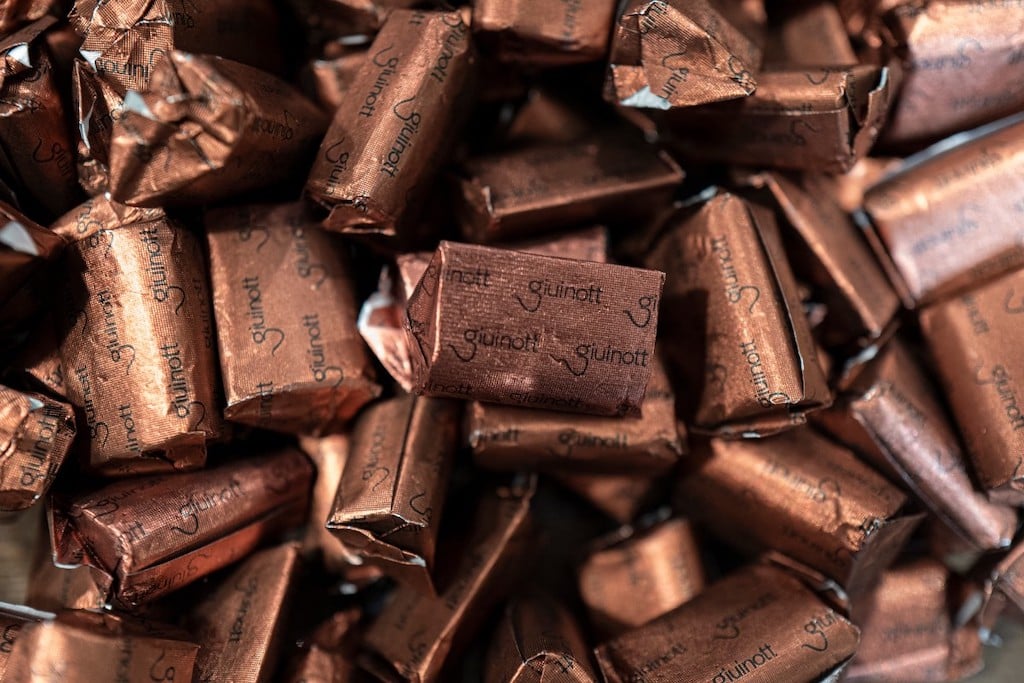
Wrapped gianduiotti chocolates. Photo by MARCO BERTORELLO / AFP.
But it was not until 1865 that the Piedmontese hazelnut paste took the name of a carnival figure, Gianduia, the symbol of Turin, and was marketed by Caffarel.
"Caffarel knows where to find us and if they think there may be an opening, we are ready to discuss it with them," said Antonio Borra, a lawyer for the PGI committee.
But, he warned: "There are points on which we cannot compromise, starting with the name of Turin, which belongs to the whole territory, not a single company."
Comments
See Also
Turin's famed gianduiotto, a small, creamy chocolate that melts on the tongue, is at the centre of a battle for European recognition pitting Italian artisans against Swiss giant Lindt.
In his workshop outside the northwestern Italian city, Luca Ballesio kneads chocolate with spatulas before expertly slicing off pieces and lining them up on a tray.
The 42-year-old is one of the last chocolatiers who makes gianduiotto the old-fashioned way, a hand-made approach which gives the sweets their typical prism shape.

He is part of a committee of around 40 artisan chocolatiers, as well as companies such as Ferrero, Venchi and Domori, who are seeking to obtain a Protected Geographical Indication (PGI) for the gianduiotto from the European Union.
The goal is to raise the profile of the chocolate, increase sales - already estimated at around 200 million euros ($219 million) a year - and continue the chocolate tradition in Turin.
READ ALSO: Why did Italy choose opera over espresso in its bid for Unesco status?
But they are facing opposition from Lindt, owner since 1997 of Italian producer Caffarel, which claims to have invented the gianduiotto.
The plan is currently blocked at Italy's ministry of agriculture.

"This battle is important in promoting a historic product of Turin," Ballesio told AFP.
The committee has developed some very detailed criteria, which would have to be met by anyone hoping to secure the hoped-for PGI to their products.
Heresy
Faithful to tradition, it advocates a return to the original gianduiotto - 30 to 45 percent roasted hazelnuts from Piedmont, at least 25 percent cocoa, plus sugar.
The 200-year-old recipe is not, however, to the tastes of Lindt, which requires the addition of powdered milk and wants to reduce the hazelnut content to 26 percent.

The addition of powdered milk for many here is heresy. "For us, adding powdered milk to chocolate is like diluting wine with water," said Guido Castagna, president of the Gianduiotto Committee in Turin.
With Christmas just a few days away, production in 49-year-old Castagna's workshop in Giaveno, near the city, is in full swing.
READ ALSO: Weekend Wanderlust: A love letter to Turin
Castagna pours bag after bag of hazelnuts into a machine which roasts them before they are ground up and mixed with cocoa.
The chocolate mixture then passes through a machine which slices it and pours it directly onto a conveyer belt without using moulds.

Each chocolate is then wrapped by hand in shiny aluminium foil, ready to be placed under the Christmas tree.
"We don't want to take anything away from Caffarel. We're not fighting a war against Caffarel. For us Caffarel can easily continue its production," Castagna told AFP.
- Naval blockade -
"But it must be clear to Caffarel that we are defending the gianduiotto as it was originally made."
Caffarel, for its part, insists it had never opposed the recognition of a PGI certificate, which it says would "contribute to the prestige of gianduiotto in Italy and across the world".

But the Lindt subsidiary already has its own brand, "Gianduia 1865 - the authentic Gianduiotto of Turin" and fears the creation of a similar PGI, "Gianduiotto of Turin", will cause confusion.
"Our objective is to find an agreement which satisfies all parties and which allows Caffarel to protect the historic value of its brand," the company said.
The chocolates date back to the naval blockade ordered by Napoleon against Britain and its empire in 1806, which created a shortage of cocao on mainland Europe.
Turin chocolatiers went on to use hazelnuts - which are abundant in the region - for the first time.

But it was not until 1865 that the Piedmontese hazelnut paste took the name of a carnival figure, Gianduia, the symbol of Turin, and was marketed by Caffarel.
"Caffarel knows where to find us and if they think there may be an opening, we are ready to discuss it with them," said Antonio Borra, a lawyer for the PGI committee.
But, he warned: "There are points on which we cannot compromise, starting with the name of Turin, which belongs to the whole territory, not a single company."
Join the conversation in our comments section below. Share your own views and experience and if you have a question or suggestion for our journalists then email us at [email protected].
Please keep comments civil, constructive and on topic – and make sure to read our terms of use before getting involved.
Please log in here to leave a comment.